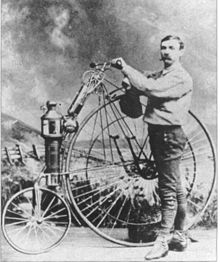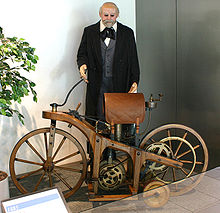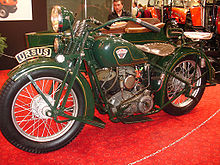1929Brough
One of the finest examples of a pre WW1 Harley Davidson to exist. All original and in perfect running condition.
Vintage 1913 Harley Davidson Classic Antique Wonder.
Motorcycle history begins in the second half of the 19th century. Motorcycles are descended from the "safety bicycle," a bicycle with front and rear wheels of the same size and a pedal crank mechanism to drive the rear wheel.[1] Despite some early landmarks in its development, motorcycles lack a rigid pedigree that can be traced back to a single idea or machine. Instead, the idea seems to have occurred to numerous engineers and inventors around Europe at around the same time.
Early pioneers
Steam power
In the 1860s Pierre Michaux, a blacksmith in Paris, founded 'Michaux et Cie' ("Michaux and company"), the first company to construct bicycles with pedals called a velocipede at the time, or "Michauline".[2] The first steam powered motorcycle, the Michaux-Perreaux steam velocipede, can be traced to 1867, when Pierre's son Ernest Michaux fitted a small steam engine to one of the 'velocipedes'.[3]The design went to the USA when Pierre Lallement, a Michaux employee who also claimed to have developed the prototype in 1863, filed for the first bicycle patent with the U.S. patent office in 1866.[4] In 1868 an American, Sylvester H. Roper of Roxbury, Massachusetts developed a twin-cylinder steam velocipede, with a coal-fired boiler between the wheels. Roper's contribution to motorcycle development ended suddenly when he died demonstrating one of his machines in Cambridge, Massachusetts on June 1, 1896.[3]
Also in 1868, a French engineer Louis-Guillaume Perreaux patented a similar steam powered single cylinder machine, the Michaux-Perreaux steam velocipede, with an alcohol burner and twin belt drives, which was possibly invented independently of Roper's. Although the patent is dated 1868, nothing indicates the invention had been operable before 1871.[3]
In 1881, Lucius Copeland of Phoenix, Arizona designed a much smaller steam boiler which could drive the large rear wheel of an American Star high-wheeler at 12 mph. In 1887 Copeland formed the Northrop Manufacturing Co. to produce the first successful 'Moto-Cycle' (actually a three-wheeler).[3]
Petroleum power
Previous engines designed by Nikolaus Otto had been powered by town gas.[5] The German name Reitwagen means "riding car". Daimler created this machine solely as a testbed to prove that his Grandfather Clock engine could work in a vehicle.[6][7]
First commercial products
In the decade from the late 1880s, dozens of designs and machines emerged, particularly in France, Germany and England, and soon spread to America.[8] During this early period of motorcycle history, there were many manufacturers since bicycle makers were adapting their designs for the new internal combustion engine.In 1894, the Hildebrand & Wolfmüller became the first motorcycle available to the public for purchase.[9] However, only a few hundred examples of this motorcycle were ever built. Soon, as the engines became more powerful and designs outgrew the bicycle origins, the number of motorcycle-oriented producers increased.
The first known motorcycle in the United States was said to be brought to New York by a French circus performer, in 1895. It weighed about 200 lb (91 kg) and was capable of 40 mph (64 km/h) on a level surface.[10]
However, that same year, an inventor from the United States, E.J. Pennington, demonstrated a motorcycle of his own design in Milwaukee. Pennington claimed his machine was capable of a speed of 58 mph (93 km/h), and is credited with inventing the term "motor cycle" to describe his machine.[11]
The 20th century
Before World War II
In 1901 English quadricycle and bicycle maker Royal Enfield introduced its first motorcycle, with a 239 cc engine mounted in the front and driving the rear wheel through a belt. In 1898, English bicycle maker Triumph decided to extend its focus to include motorcycles, and by 1902, the company had produced its first motorcycle—a bicycle fitted with a Belgian-built engine.In 1903, as Triumph's motorcycle sales topped 500, the American company Harley-Davidson started producing motorcycles.
In 1901, the Indian Motocycle Manufacturing Company, which had been founded by two former bicycle racers, designed the so-called "diamond framed" Indian Single, whose engine was built by the Aurora Firm in Illinois per Indian's specifications. The Single was made available in the deep blue. Indian's production was up to over 500 bikes by 1902, and would rise to 32,000, its best ever, in 1913.
During this period, experimentation and innovation were driven by the popular new sport of motorcycle racing, with its powerful incentive to produce tough, fast, reliable machines. These enhancements quickly found their way to the public’s machines.[8]
By 1931, Indian and Harley-Davidson were the only two American manufacturers producing commercial motorcycles.[13] This two-company rivalry in the United States remained until 1953, when the Indian Motorcycle factory in Springfield, Massachusetts closed and Royal Enfield took over the Indian name.[14]
There were over 80 different makes of motorcycle available in Britain in the 1930s, from the familiar marques like Norton, Triumph and AJS to the obscure, with names like New Gerrard, NUT, SOS, Chell and Whitwood,[15] about twice as many motorcycle makes competing in the world market during the early 21st century.
In 1937, Joe Petrali set a new land speed record of 136.183 mph (219.165 km/h) on a modified Harley-Davidson 61 cubic inch (1,000 cc) overhead valve-driven motorcycle.[13] The same day, Petrali also broke the speed record for 45 cubic inch (737 cc) engine motorcycles.
In Europe, production demands, driven by the buildup to World War II, included motorcycles for military use, and BSA supplied 126,000 BSA M20 motorcycles to the British armed forces, starting in 1937 and continuing until 1950. Royal Enfield also produced motorcycles for the military, including a 125 cc lightweight motorcycle that could be dropped (in a parachute-fitted tube cage) from an aircraft.
After World War II
More History at Wikipedia
http://en.wikipedia.org/wiki/Motorcycle_history
Source: Wikipedia
TTFN
CYA Later Taters
Thanks for watching.
Donnie/ Sinbad the Sailor Man








No comments:
Post a Comment